Puebloans
The Puebloans or Pueblo peoples, are Native Americans in the Southwestern United States who share common agricultural, material, and religious practices. Currently 100 pueblos are actively inhabited, among which Taos, San Ildefonso, Acoma, Zuni, and Hopi are the best-known. Pueblo people speak languages from four different language families, and each Pueblo is further divided culturally by kinship systems and agricultural practices, although all cultivate varieties of maize.
| Total population | |
|---|---|
| c. 75,000[1] | |
| Regions with significant populations | |
| US c. 75,000 | |
| Particularly: New Mexico and Arizona | |
| Languages | |
| English (NM, US), Indigenous languages of New Mexico (Jemez, Jicarilla, Keresan, Keresan Pueblo Sign Language, Picuris, Southern Tiwa, Taos, Tewa, Zuni) | |
| Religion | |
| Katsina religion, Roman Catholicism[2] |
Pueblo peoples have lived in the American Southwest for millennia and descend from Ancestral Pueblo peoples.[3] The term Anasazi is sometimes used to refer to ancestral Pueblo people but it is now largely minimized. Anasazi is a Navajo word that means Ancient Ones or Ancient Enemy, hence Pueblo peoples' rejection of it (see exonym).[4]
Pueblo is a Spanish term for "village." When Spaniards entered the area, beginning in the 16th-century with the founding of Nuevo México, they came across complex, multistory villages built of adobe, stone and other local materials. New Mexico contains the most federally recognized Pueblo communities, but some Pueblo communities can be found in Arizona and Texas, mostly in the Sangre de Cristo Mountains and along the Rio Grande and Colorado rivers and their tributaries.
Pueblo nations have maintained much of their traditional cultures, which center around agricultural practices, a tight-knit community revolving around family clans, and respect for tradition. Puebloans have been remarkably adept at preserving their culture and core religious beliefs, including developing syncretic Pueblo Christianity.[5] Exact numbers of Pueblo peoples are unknown but, in the 21st century, some 75,000 Pueblo people[1] live predominantly in live in New Mexico and Arizona, but also Texas and elsewhere.
Subdivisions

Despite various similarities in cultural and religious practices, scholars have proposed divisions of contemporary Pueblos into smaller groups based on linguistic and individual manifestations of the broader Puebloan culture.
Linguistic affiliation
The clearest division between Puebloans relates to the languages they speak. Pueblo peoples speak languages from four distinct language families, which means these languages are completely different in vocabulary, grammar, and most other linguistic aspects. As a result, each Pueblo language is often completely unintelligible to the other languages, with English now working as the lingua franca of the region.
- Keresan: family to which Western and Eastern Keres belong, considered by some a language isolate consisting of a dialect continuum spoken at the pueblos of Acoma, Laguna, Santa Ana, Zia, Cochiti, Kewa, and San Felipe.
- Kiowa-Tanoan: stock to which the Tanoan (or Puebloan) branch belongs, consisting of three separate sub-branches:
- Towa: currently solely spoken at Jemez Pueblo.
- Tewa: the most widespread Tanoan language with several dialects, spoken at Ohkay Owingeh, San Ildefonso, Santa Clara, Tesuque, Nambé, and Pojoaque Pueblos.
- Tiwa: the only Tanoan sub-branch consisting of separate languages:[6]
- Northern Tiwa: a language with two dialects, one spoken at Taos and the other at Picuris.
- Southern Tiwa: also consisting of two dialects, spoken at Sandia and Isleta Pueblos.[7]
- Uto-Aztecan: stock to which Hopi belongs, spoken exclusively at Hopi Pueblo.
- Zuni: family to which Zuni belongs; it is a language isolate, currently spoken exclusively at Zuni Pueblo.
Cultural practices

Anthropologists have studied Pueblo peoples extensively and published various classifications of their subdivisions. In 1950, Fred Russell Eggan contrasted the peoples of the Eastern and Western Pueblos, based largely on their subsistence farming techniques.[8] The Western or Desert Pueblos of the Zuni and Hopi specialize in dry farming, compared to the irrigation farmers of the Eastern or River Pueblos. Both groups cultivate mostly maize (corn), but squash and beans have also been staple Pueblo foods all around the region.
In 1954, Paul Kirchhoff published a division of Pueblo peoples into two groups based on culture.[9] The Hopi, Zuni, Keres and Jemez each have matrilineal kinship systems: children are considered born into their mother's clan and must marry a spouse outside it, an exogamous practice. They maintain multiple kivas for sacred ceremonies. Their creation story tells that humans emerged from the underground. They emphasize four or six cardinal directions as part of their sacred cosmology, beginning in the north. Four and seven are numbers considered significant in their rituals and symbolism.[9] In contrast, the Tanoan-speaking Puebloans (other than Jemez) have a patrilineal kinship system, with children considered born into their father's clan. They practice endogamy, or marriage within the clan. They have two kivas or two groups of kivas in their pueblos. Their belief system is based in dualism. Their creation story recounts the emergence of people from underwater. They use five directions, beginning in the west. Their ritual numbers are based on multiples of three.[9]
History of the Puebloans
Precursors
Puebloan societies contain elements of three major cultures that dominated the Southwest United States region before European contact: the Mogollon culture, whose adherents occupied an area near Gila Wilderness; the Hohokam culture; and the Ancestral Pueblo culture who occupied the Chaco Canyon and Mesa Verde regions of the Four Corners area.[10][11]
Archeological evidence suggests that people partaking in the Mogollon culture /moʊɡəˈjoʊn/ were initially foragers who augmented their subsistence through the development of farming. Around the first millennium CE, however, farming became the main means to obtain food. Water control features are common among Mimbres branch sites, which date from the 10th through 12th centuries CE. The nature and density of Mogollon residential villages changed through time. The earliest Mogollon villages were small hamlets composed of several pithouses (houses excavated into the ground surface, with a stick and thatch roofs supported by a network of posts and beams, and faced on the exterior with earth). Village sizes increased over time and, by the 11th century, villages composed of ground level dwellings made with a rock and earth walls, with roofs supported by post and beam networks, became common. Cliff-dwellings became common during the 13th and 14th centuries.
Hohokam is a term borrowed from the O'odham language, used to define an archaeological culture that relied on irrigation canals to water their crops since as early as the 9th century CE. Their irrigation system techniques allowed for its adherents to expand into the largest population in the Southwest by 1300. Archaeologists working at a major archaeological dig in the 1990s in the Tucson Basin, along the Santa Cruz River, identified a culture and people that were ancestors of the Hohokam who might have occupied southern Arizona as early as 2000 BCE. This prehistoric group from the Early Agricultural Period grew corn, lived year-round in sedentary villages, and developed sophisticated irrigation canals from the beginning of the common era to about the middle of the 15th century. Within a larger context, the Hohokam culture area inhabited a central trade position between the Patayan situated along with the Lower Colorado River and in southern California; the Trincheras of Sonora, Mexico; the Mogollon culture in eastern Arizona, southwest New Mexico, and northwest Chihuahua, Mexico; and the Ancestral Puebloans in northern Arizona, northern New Mexico, southwest Colorado, and southern Utah.
The Ancestral Puebloan culture is known for the stone and earth dwellings its people built along cliff walls, particularly during the Pueblo II and Pueblo III eras, from about 900 to 1350 CE in total. The best-preserved examples of the stone dwellings are now protected within United States' national parks, such as Navajo National Monument, Chaco Culture National Historical Park, Mesa Verde National Park, Canyons of the Ancients National Monument, Aztec Ruins National Monument, Bandelier National Monument, Hovenweep National Monument, and Canyon de Chelly National Monument. These villages were accessible only by rope or through rock climbing. However, the first Ancestral Puebloan homes and villages were based on the pit-house, a common feature in the Basketmaker periods. Villages consisted of apartment-like complexes and structures made from stone, adobe mud, and other local materials, or were carved into the sides of canyon walls. Design details from Ancestral Puebloan villages contain elements from cultures as far away as present-day Mexico. In their day, these ancient towns and cities were usually multistoried and multi-purposed buildings surrounding open plazas and viewsheds. They were occupied by hundreds to thousands of Ancestral Pueblo peoples. These population complexes hosted cultural and civic events and infrastructure that supported a vast outlying region hundreds of miles away linked by transportation roadways.
Development of architecture and city-states
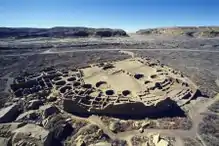
By about 700 to 900 CE, the Puebloans began to move away from ancient pit houses dug in cliffs and to construct connected rectangular rooms arranged in apartment-like structures made of adobe and adapted to sites. By 1050, they had developed planned villages composed of large terraced buildings, each with many rooms. These apartment-house villages were often constructed on defensive sites: on ledges of massive rock, on flat summits, or on steep-sided mesas, locations that would afford the Puebloans protection from raiding parties originating from the north, such as the Comanche and Navajo. The largest of these villages, Pueblo Bonito in Chaco Canyon, New Mexico, contained around 700 rooms in five stories; it may have housed as many as 1000 persons.[12] Pueblo buildings are constructed as complex apartments with numerous rooms, often built in strategic defensive positions. The most highly developed were large villages or pueblos situated at the very top of the mesas, the rocky tablelands typical to the Southwest.
European contact and revolt
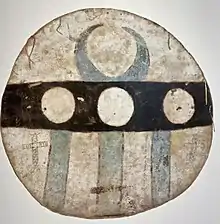

Before 1598, Spanish exploration of the present-day Pueblo areas was limited to an assortment of small groups. A group of colonizers led by Juan de Oñate arrived at the end of the 16th Century as part of an apostolic mission to convert the Natives. Despite initial peaceful contact, Spain's attempts to dispose of the Pueblo religion and replace it with Catholicism became increasingly more aggressive, and were met with great resistance by Puebloans, whose governmental structure was based around the figure of the cacique, a theocratic leader for both material and spiritual matters.[5] Over the years, Spaniards' methods grew harsher, leading to a series of revolts by the Puebloans.
The Pueblo Revolt that started in 1680 was the first led by a Native American group to successfully expel colonists from North America for a considerable number of years. It followed the successful Tiguex War led by Tiwas against the Coronado Expedition in 1540–41, which temporarily halted Spanish advances in present-day New Mexico. The 17th Century's revolt was a direct consequence of growing discontent among the Northern Pueblos against the abuses by the Spaniards, which finally brewed into a large organized uprising against European colonizers.
The events that led to the Pueblo Revolt go back at least a decade before the formal uprising began. In the 1670s, severe drought swept the region, which caused both a famine among the Pueblo and increased the frequency of raids by the Apache. Neither Spanish nor Pueblo soldiers were able to prevent the attacks by the Apache raiding parties.
The unrest among the Pueblos came to a head in 1675, when Governor Juan Francisco Treviño ordered the arrest of forty-seven Pueblo medicine men and accused them of practicing sorcery. Four of the medicine men were sentenced to death by hanging; three of those sentences were carried out, while the fourth prisoner committed suicide. The remaining men were publicly whipped and sentenced to prison. When the news of the killings and public humiliation reached Pueblo leaders, they moved in force to Santa Fe, where the prisoners were held. Because a large number of Spanish soldiers were away fighting the Apache, Governor Treviño was forced to release the prisoners. Among those released was an Ohkay Owingeh Tewa man named Popé. After being released, Popé took up residence in Taos Pueblo far from the capital of Santa Fe and spent the next five years seeking support for a revolt among the 46 Pueblo villages. He was able to gain the support of the Northern Tiwa, Tewa, Towa, Tano, and Keres-speaking Pueblos of the Rio Grande Valley. The Pecos Pueblo, 50 miles east of the Rio Grande pledged its participation in the revolt as did the Zuni and Hopi, 120 and 200 miles respectively west of the Rio Grande. At the time, the Spanish population was of about 2,400 colonists, including mixed-blood mestizos, and Indian servants and retainers, who were scattered thinly throughout the region. Starting early on 10 August, 1680, Popé and leaders of each of the Pueblos sent a knotted rope carried by a runner to the next Pueblo; the number of knots signified the number of days to wait before beginning the uprising. Finally, on 21 August, 2,500 Puebloan warriors took the colony's capital Santa Fe from Spanish control, killing many colonizers, the remainder of whom were successfully expelled.[13]
On 22 September 2005, the statue of Po'pay (Popé), the leader of the Pueblo Revolt, was unveiled in the Capitol Rotunda in Washington, D.C. The statue was the second commissioned by the state of New Mexico for the National Statuary Hall Collection; it was the 100th and last to be added to the collection. It was created by Cliff Fragua, a Puebloan from Jemez Pueblo, New Mexico. It is the only statue in the collection to be created by a Native American.[14]
Culture

In 1844 Josiah Gregg described the historic Pueblo people in The journal of a Santa Fé trader as follows:[15]
When these regions were first discovered it appears that the inhabitants lived in comfortable houses and cultivated the soil, as they have continued to do up to the present time. Indeed, they are now considered the best horticulturists in the country, furnishing most of the fruits and a large portion of the vegetable supplies that are to be found in the markets. They were until very lately the only people in New Mexico who cultivated the grape. They also maintain at the present time considerable herds of cattle, horses, etc. They are, in short, a remarkably sober and industrious race, conspicuous for morality and honesty, and very little given to quarreling or dissipation ...
Material culture
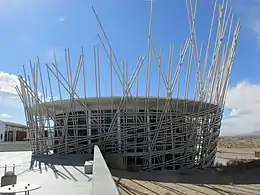
The Puebloans are traditional weavers of cloth and have used textiles, natural fibers, and animal hide in their cloth-making. Since woven clothing is laborious and time-consuming, every-day style of dress for working around the villages has been sparer. The men often wore breechcloths.
Agriculture
Corn is the most readily recognizable staple food for Pueblo peoples. Although it is possible that different groups may have grown local plants such as gourds and chenopods at very early dates, the first evidence of maize cultivation in the Southwest dates from about 2100 BCE. Small, fairly undomesticated maize cobs have been found at five different sites in New Mexico and Arizona.[16]
Maize reached the present-day Southwest via an unknown route from Mesoamerica (i.e., present-day Mexico) and was rapidly adopted by peoples in the region. One theory states that maize cultivation was carried northward from central Mexico by migrating farmers, most likely speakers of a Uto-Aztecan language. Another theory, more accepted among scholars, is that between 4300 BCE and 2100 BCE maize was diffused northward from group to group between rather than migrants. There is evidence that maize was initially cultivated in the Southwest during a climatic period when precipitation was relatively high.[16]
Pottery
The various Pueblo communities have different traditions regarding the making and decoration of pottery artifacts. Present-day archaeologists date the use of pottery by Puebloans dating back the early centuries of the Common Era.[17]
 San Ildefonso Pueblo Black-on-Black Pottery Bowl by Maria Martinez
San Ildefonso Pueblo Black-on-Black Pottery Bowl by Maria Martinez.jpg.webp) Zuni owl figure, University of British Columbia
Zuni owl figure, University of British Columbia Acoma Pueblo, pottery jar, Field Museum
Acoma Pueblo, pottery jar, Field Museum Tesuque Pueblo, Pottery, Field Museum
Tesuque Pueblo, Pottery, Field Museum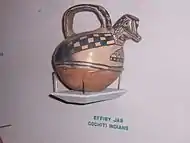 Bird effigy, pottery, Cochiti Pueblo. Field Museum
Bird effigy, pottery, Cochiti Pueblo. Field Museum
Religion
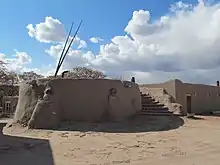
In Native communities of the Southwest's belief system, the archetypal deities appear as visionary beings who bring blessings and receive love. A vast collection of religious stories explore the relationships among people and nature, including plants and animals. Spider Grandmother and kachina spirits figure prominently in some myths.

Pueblo prayer included substances as well as words; one common prayer material was ground-up maize – white cornmeal. A man might bless his son, or some land, or the town by sprinkling a handful of meal as he uttered a blessing. After the 1692 re-conquest, the Spanish were prevented from entering one town when they were met by a handful of men who uttered imprecations and cast a single pinch of a sacred substance.[18]
The Pueblo peoples used ritual 'prayer sticks', which were colorfully decorated with beads, fur, and feathers. These prayer sticks (or 'talking sticks') were similar to those used by other Native American nations. By the 13th century, Puebloans used turkey feather blankets for warmth.[19]
Most of the Pueblos hold annual sacred ceremonies, some of which are now open to the public.
Religious ceremonies usually feature traditional dances that are held outdoors in the large common areas and courtyards, which are accompanied by singing and drumming. Unlike kiva ceremonies, traditional dances may be open to non-Puebloans. Traditional dances are considered a form of prayer, and strict rules of conduct apply to those who wish to attend one (e.g. no clapping or walking across the dance area or between the dancers, singers, or drummers).[20]
Since time immemorial, Pueblo communities have celebrated seasonal cycles through prayer, song, and dance. These dances connect us to our ancestors, community, and traditions while honoring gifts from our Creator. They ensure that life continues and that connections to the past and future are reinforced.[21]
Traditionally, all outside visitors to a public dance would be offered a meal afterward in a Pueblo home. Because of the numerous outside tourists who have attended these dances in the pueblos since the late 20th century, such meals are now open to outsiders by personal invitation only. Private sacred ceremonies are conducted inside the kivas and only tribal members may participate according to specific rules pertaining to each Pueblo's religion. One of the primary goals of Spanish colonists in the 17th Century was the desire to bring Christianity to Natives in New Spain. Franciscan priests had prepared for a long process of conversion, building churches and missions all around Pueblo country. Pueblos' feast days are a product of that process. Feast days are held on the day sacred to its Roman Catholic patron saint, assigned by Spanish missionaries so that each Pueblo's feast day would coincide with one of the people's existing traditional ceremonies. About the imposition of Christianity, Alfonso Ortiz, an Ohkay Owingeh anthropologist and Pueblo specialist states:
The Spanish government demanded labor and tribute from the Pueblos and vigorously attempted to suppress native religion. (...) In that year [1692] Diego de Vargas re-entered Pueblo territory, though it was not until 1696 that he gained control over the entire Rio Grande Pueblo area. The Spaniards had learned from the Pueblo Revolt and were gentler in their demands in the next century and a half. However, the Pueblos had learned as well and maintained their ceremonial life out of the view of the Spaniards, while adopting a veneer of Roman Catholicism.[22]
The public observances may also include a Roman Catholic Mass and processions on the Pueblo's feast day. Some Pueblos also hold sacred ceremonies around Christmas and at other Christian holidays.
List of Pueblos
New Mexico
- Acoma Pueblo – Keres speakers. Known for its location atop a mesa. Established in the 12th Century, it is one of the oldest continuously inhabited places in the United States.
- Cochiti Pueblo – Keres speakers. Known for its ceramic storyteller figurines, drums, and the nearby Cochiti Dam
- Isleta Pueblo – Tiwa speakers. Established in the 14th century. Located on the southern outskirts of Albuquerque.
- Jemez Pueblo – Towa speakers. Known for its runners and running ceremonies.
- Kewa Pueblo (formerly Santo Domingo) – Keres speakers. Known for turquoise work and the Corn Dance.
- Laguna Pueblo – Keres speakers. Known for its well-preserved 17th Century mission church.
- Nambé Pueblo – Tewa language speakers. Established in the 14th century. Was an important trading center for the Northern Pueblos.
- Ohkay Owingeh Pueblo (formerly San Juan) – Tewa speakers. Headquarters of the Eight Northern Indian Pueblos Council. Home of Popé, one of the leaders of the 1680 Pueblo Revolt against Spanish colonizers.
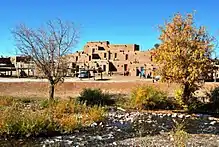 Taos Pueblo, view from the South
Taos Pueblo, view from the South - Picuris Pueblo – Tiwa speakers. Known for its micaceous pottery.
- Pojoaque Pueblo – Tewa speakers. Re-established in the 1930s.
- Sandia Pueblo – Tiwa speakers. Established in the 14th Century. Located on the northern outskirts of Albuquerque.
- San Felipe Pueblo – Keres speakers.
- San Ildefonso Pueblo – Tewa speakers. Famous for its valuable black-on-black pottery. Located between Pojoaque and Los Alamos.
- Santa Ana Pueblo – Keres speakers.
- Santa Clara Pueblo – Tewa speakers. Established in the 16th Century. Located near Española.
- Taos Pueblo – Tiwa speakers. Known for its architecture. Established in the 11th Century, it is one of the oldest continuously inhabited places in the United States.
- Tesuque Pueblo – Tewa speakers. Known for the Pueblo Revolt of 1680, Camel Rock Monument, and its ceramic Rain God figurines. Located near Santa Fe.
- Zia Pueblo – Keres speakers. Known for their sun symbol, which is New Mexico's state flag.
- Zuni Pueblo – Zuni speakers. Known for being the first Pueblo visited by the Spanish in 1540.
Arizona
- Hopi Tribe Nevada-Kykotsmovi – Hopi language speakers. Area of present villages settled around 700 CE
Texas
- Ysleta del Sur Pueblo, El Paso, Texas – originally Tigua (Spanish: Tiwa speakers.[lower-alpha 1] Also spelled 'Isleta del Sur Pueblo'.) This Pueblo was established in 1680 as a result of the Pueblo Revolt. Some 400 members of Isleta, Socorro, and neighboring pueblos were forced out or accompanied the Spaniards to El Paso as they fled Northern New Mexico.[26] The Spanish fathers established three missions (Ysleta, Socorro, and San Elizario) on the Camino Real between Santa Fe and Mexico City. The San Elizario mission was administrative (that is, non-Puebloan).
- Some of the Piro Puebloans settled in Seneca, and then in Socorro, Texas, adjacent to Ysleta (which is now within El Paso city limits). When the Rio Grande flooded the valley or changed course, as it commonly has over the centuries, these missions have sometimes been associated with Mexico or with Texas due to the changes. Socorro and San Elizario are still separate communities; Ysleta has been annexed by El Paso.
- Firecracker Pueblo,[27] Jornada Mogollon culture, abandoned 2nd half of the fifteenth c., excavated beginning 1980. Illustrates the evolution from pit-houses to a linear array of 15–17 rooms. The walls were coursed adobe; the floors were plastered caliche. Room 11 had metates and a mano for grinding corn. (Note that metates exist in the stone floors of caves of nearby Hueco Tanks as well.) Located in El Paso County, Texas.
Endonyms and exonyms
Although most present-day pueblos are known by their Spanish or anglicized Spanish name, each Pueblo has a unique name in each of the different languages spoken in the area. The names used by each Pueblo to refer to their village (endonyms) usually differ from those given to them by outsiders (their exonyms), including by speakers of other Puebloan languages. Centuries of trade and intermarriages between the groups are reflected in the names given to the same Pueblo in each of the languages. The table below contains the names of the New Mexican pueblos and Hopi using the official or practical orthographies of the languages. Despite not being a Puebloan language, Navajo names are also included due to prolonged contact between them and the several Pueblos.
| English/Spanish Name | Endonym[10] | Navajo[28] | Keres[10][29] | Tewa[10][6] | Tiwa[10][6][lower-alpha 1] | Towa[6][30] | Hopi[31] | Zuni[10] |
|---|---|---|---|---|---|---|---|---|
| Acoma | Áakʼu | Haakʼoh | endonym | Téwigeh Ówîngeh | Tʼoławei | Totyagiʼi | Ákookavi | Haku: |
| Cochiti | Kúutyì | Tǫ́ʼgaaʼ | Kʼuuteʼgeh Ówîngeh | Kotəava | Kyʼǽǽtɨɨgiʼi | Kwitsi | Kochudi | |
| Laguna | Kʼáwáiga | Tó Łání | Kʼuʼkwʼáage Ówîngeh | Powhiaba | Kyʼóóweʼegiʼi | Kawaikaʼa | Kʼyanałana | |
| San Felipe | Kaatishtya | Dibé Łizhiní | Nąnwheve Ówîngeh | Pʼatəak | Kwilegiʼi | Katistsa | Wepłabattsʼi | |
| Santa Ana | Dámáyá | Dahmi | Shadegeh Ówîngeh | Patuthaa | Tɨ̨́dægiʼi | Tamaya | Damaiya | |
| Kewa/Santo Domingo | Kewa/ Díiwi | Tó Hájiiloh | Taywheve Ówîngeh | Tuwita | Tǽwigiʼi | Tuuwíʼi | Wehkʼyana | |
| Zia | Tsíiyʼa | Tłʼógí | Sia Ówîngeh | Təanąbak | Sæyakwa | Tsiyaʼ | Tsia'a | |
| Nambé | Nąngbeʼe Ôwîngeh | (Not Available) | Nomɨʼɨ | endonym | Nammuluva | Pashiukwa | Tuukwiveʼ Tewa | (Not Available) |
| Pojoaque | Pʼohsųwæ̨geh Ówîngeh | (Not Available) | Pʼohwakedze | Asʼonaʼ | (Not Available) | (Not Available) | (Not Available) | |
| San Ildefonso | Pʼohwhogeh Ówîngeh | Tsétaʼ Kin | Pʼakwede | Pʼahwiaʼhliap | Pʼææshogiʼi | Suustapna Tewa | Dawsa | |
| Ohkay Owingeh/San Juan | Ohkwee Ówîngeh | Kin Łigaai | (Not Available) | Pʼakapʼalʼayą | (Not Available) | Yuupaqa Tewa | (Not Available) | |
| Santa Clara | Khaʼpʼoe Ówîngeh | Naashashí | Kaipʼa | Haipaai | Shǽǽpʼæægiʼi | Nasaveʼ Tewa | (Not Available) | |
| Tesuque | Tetsʼúgéh Ówîngeh | Tłʼoh Łikizhí | Tyutsuko | Tutsʼuiba | Tsota | Tuukwiveʼ Tewa | (Not Available) | |
| Isleta | Shiewhibak/ Tsugwevaga | Naatoohó | Dyîiwʼaʼane | Tsiiwheve Ówîngeh | endonym | Téwaagiʼi | Tsiyawipi | Kʼya:shhida |
| Picuris | Pʼįwweltha / Pe’ewi | Tókʼelé | Pikuli | Pʼįnwêê Ówîngeh | Pʼêêkwele | (Not Available) | (Not Available) | |
| Sandia | Na’piʼad | Kin Łichíí | Waashuutsi | Pʼotsą́nûû Ówîngeh | Sądéyagiʼi | Payúpki | We:łuwalʼa | |
| Taos | Təotho | Tówoł | Dâusá | Pʼįnsô Ówîngeh | Yɨ́láta | Kwapihalu | Dopoliana | |
| Jemez | Wâlatɨɨwa | Maʼii Deeshgiizh | Héemʼishiitsi | Wą́ngé Ówîngeh | Híemma | endonym | Hemisi | He:mu:shi |
| Hopi | Móókwi/ Hópi | Ayahkiní | Mùutsi | Khosóʼon | Bukhiek | Hɨ́pé | endonym | Mu:kwi |
| Zuni | Shiwinna | Naashtʼézhí | Sɨ́ɨníitsi | Sųyų | Sunyiʼina | Sɨnigiʼi | Síʼooki | endonym |
| Navajo People | Diné | endonym | Tene | Wǽn Sávo | (Not Available) | Kyʼælætoosh | Tasavu | A:Machu |
With the exception of Zuni, all Puebloan languages, as well as Navajo, are tonal. However, the tone is not usually shown in the spelling of these languages save for Navajo, Towa, and Tewa. In the table above, a low tone is left unmarked in the orthography. Vowel nasalisation is shown by an ogonek diacritic below the vowel; ejective consonants are transcribed with an apostrophe following the consonant. Vowel length is shown either by doubling of the character or, in Zuni, by adding a colon.
Feast days
- January
- San Ildefonso Pueblo Feast Day: 23 January.
- May
- San Felipe Pueblo Feast Day: 1 May
- Texas Band of Yaqui Indians 27 May: Recognition Celebrations
- June
- Ohkay Owingeh Pueblo Feast Day: 24 June
- Sandia Pueblo Feast Day: 13 June.
- Ysleta / Isleta del Sur Pueblo Feast Day: 13 June.
- July
- Cochiti Pueblo Feast Day: 14 July
- Santa Ana Pueblo Feast Day: 26 July
- August
- Picuris Pueblo Feast Day: 10 August
- Jemez Pueblo Feast Day: 2 August
- Santo Domingo Pueblo Feast Day: 4 August
- Santa Clara Pueblo Feast Day : 12 August
- Zia Pueblo Feast Day: 15 August
- September
- Acoma Pueblo Feast Day of San Esteban del Rey: 2 September
- Laguna Pueblo Feast Day: 19 September
- Taos Pueblo Feast Day: 30 September
- October
- Nambe Pueblo Feast Day of St. Francis: 4 October
- November
Jemez Pueblo Feast Day: 12 November
- Tesuque Pueblo Feast Day of San Diego: 12 November
- December
- Pojoaque Pueblo Feast Day: 12 December
- Variable
- Isleta Pueblo Feast Days
See also
- Ancestral Puebloans
- Arizona Tewa
- Astialakwa
- Casas Grandes
- Hopi
- Keresan languages
- Navajo people
- Pueblo Revolt
- Tanoan languages
- Tewa people
- Tiwa languages
- Carol Jean Vigil
- Zuni people
Notes
References
- "Pueblo Indians – History & Facts". Encyclopedia Britannica. Retrieved 3 June 2021.
- "Rio Grande Pueblos". American National History Museum. Retrieved 6 August 2022.
- McGuire, Randall H. (2011). Glowacki, Donna M.; Van Keuren, Scott (eds.). Religious Transformation in the Late Pre-Hispanic Pueblo World. Tucson: University of Arizona Press. ISBN 9780816503988.
- Cordell, Linda (1994). Ancient Pueblo Peoples. St. Remy Press and Smithsonian Institution. p. 18–19. ISBN 0-89599-038-5.
- Sando, Joe S. (1992). Pueblo nations : eight centuries of Pueblo Indian history (1st ed.). Santa Fe, NM: Clear Light. ISBN 0940666170. OCLC 24174245.
- Sutton, Logan (2014). Kiowa-Tanoan: A Synchronic and Diachronic Study. Albuquerque, NM: University of New Mexico.
- JSTOR summary, Harry Hoijer, "American Indian Linguistics in the Southwest: Comments" American Anthropologist New Series, Vol. 56, No. 4, Southwest Issue (Aug. 1954), pp. 637–639
- Fred Russell Eggan, Social Organization of the Western Pueblos, University of Chicago Press, 1950.
- Paul Kirchhoff, "Gatherers and Farmers in the Greater Southwest: A Problem in Classification", American Anthropologist, New Series, Vol. 56, No. 4, Southwest Issue (August 1954), pp. 529–550
- Sturtevant, William C. (1978–2008). Handbook of the North American Indians. Smithsonian Institution. ISBN 0160045770. OCLC 13240086.
- Cordell, Linda S. Ancient Pueblo Peoples, St. Remy Press and Smithsonian Institution (1994); ISBN 0-89599-038-5.
- Nash, Gary B. Red, White and Black: The Peoples of Early North America Los Angeles (2015). Chapter 1, p. 4 ISBN 978-0205887590
- Paul Horgan (1954), Great River vol. 1, p. 286. LCCN 54-9867
- Po'pay dedication
- Gregg, J. 1844. Commerce of the Prairies, Chapter 14: "The Pueblos", p. 55. New York: Henry G. Langley.
- Merril, William L. (2009). "The Diffusion of Maize to the Southwest United States and its Impact". Proceedings of the National Academy of Sciences of the United States of America. 106 (50): 21019–21026. Bibcode:2009PNAS..10621019M. doi:10.1073/pnas.0906075106. PMC 2795521. PMID 19995985.
- Mera, H.P., Pueblo Designs: 176 Illustrations of the "Rain Bird", Dover Publications, Inc, 1970, first published by the Laboratory of Anthropology, Santa Fe, New Mexico (1937), p. 1
- Paul Horgan, Great River p. 158
- "Turkeys domesticated not once, but twice", physorg.com; accessed September 2015.
- "Pueblo religious etiquette".
- "Indian Pueblo Cultural Center". Archived from the original on 26 February 2022.
- Ortiz, Alfonso (1979). Handbook of the North American Indian – Volume 9 The Southwest. p. 4.
- "19 Pueblos". Archived from the original on 7 October 2015. Retrieved 22 September 2015.
- Bill Wright, Handbook of Texas (1976; updated 12 Aug 2020) Tigua Indians
- Tigua Indian Cultural Center Tigua Indian Tigua Indian Cultural Center Address 305 Yaya Lane El Paso, TX 79907
- Newadvent.org
- Texas beyond history: Firecracker Pueblo, El Paso County, Texas
- Young, Robert W.; Morgan, William (1980). The Navajo language : a grammar and colloquial dictionary (1st ed.). Albuquerque: University of New Mexico Press. ISBN 0826305369. OCLC 6597162.
- "Keres Language Project". Keres Language Project. Retrieved 13 November 2018.
- Yumitani, Yukihiro (1998). A Phonology and morphology of Jemez Towa. University of Kansas Dissertation.
- Albert, Roy; Shaul, David Leedom (1985). A concise Hopi and English lexicon. Philadelphia: J. Benjamins. ISBN 9027220158. OCLC 777549431.
Bibliography
- Fletcher, Richard A. (1984). Saint James' Catapult: The Life and Times of Diego Gelmírez of Santiago de Compostela. Oxford University Press. (on-line text, ch. 1)
- Florence Hawley Ellis An Outline of Laguna Pueblo History and Social Organization Southwestern Journal of Anthropology, Vol. 15, No. 4 (Winter, 1959), pp. 325–347
- Indian Pueblo Cultural Center in Albuquerque, NM offers information from the Pueblo people about their history, culture, and visitor etiquette.
- Gram, John R. (2015). Education at the Edge of Empire: Negotiating Pueblo Identity in New Mexico's Indian Boarding Schools. Seattle: University of Washington Press.
- Paul Horgan, Great River: The Rio Grande in North American History. Vol. 1, Indians and Spain. Vol. 2, Mexico and the United States. 2 Vols. in 1. Wesleyan University Press 1991.
- Pueblo People, Ancient Traditions Modern Lives, Marica Keegan, Clear Light Publishers, Santa Fe, New Mexico, 1998, profusely illustrated hardback, ISBN 1-57416-000-1
- Elsie Clews Parsons, Pueblo Indian Religion (2 vols., Chicago, 1939).
- Ryan D, A. L. Kroeber Elsie Clews Parsons American Anthropologist, New Series, Vol. 45, No. 2, Centenary of the American Ethnological Society (Apr. – Jun. 1943), pp. 244–255
- Parthiv S, ed. Handbook of North American Indians, Vol. 9, Southwest. Washington: Smithsonian Institution, 1976.
- Keleher, Julia M.; Chant, Elsie Ruth (2009). The Padre of Islets – The Story of Father Anton Docher. Sunstone press Publishing.
External links
- Kukadze'eta Towncrier, Pueblo of Laguna
- Pueblo of Isleta
- Pueblo of Laguna
- Pueblo of Sandia
- Pueblo of Santa Ana
- The SMU-in-Taos Research Publications digital collection contains nine anthropological and archaeological monographs and edited volumes representing the past several decades of research at the SMU-in-Taos (Fort Burgwin) campus near Taos, New Mexico, including Papers on Tao's archaeology and Tao's archeology